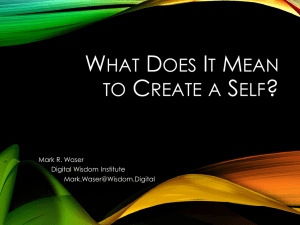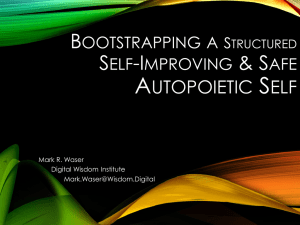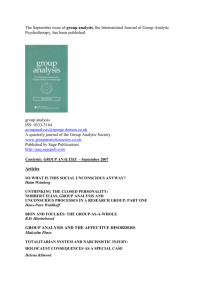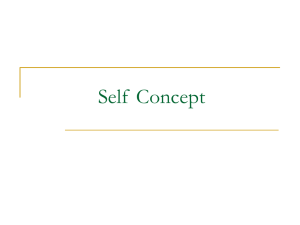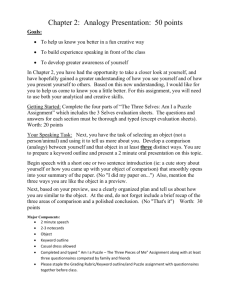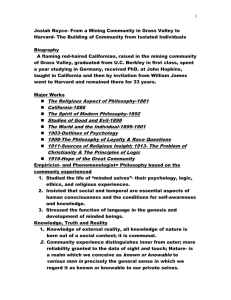Journal of English Linguistics
advertisement
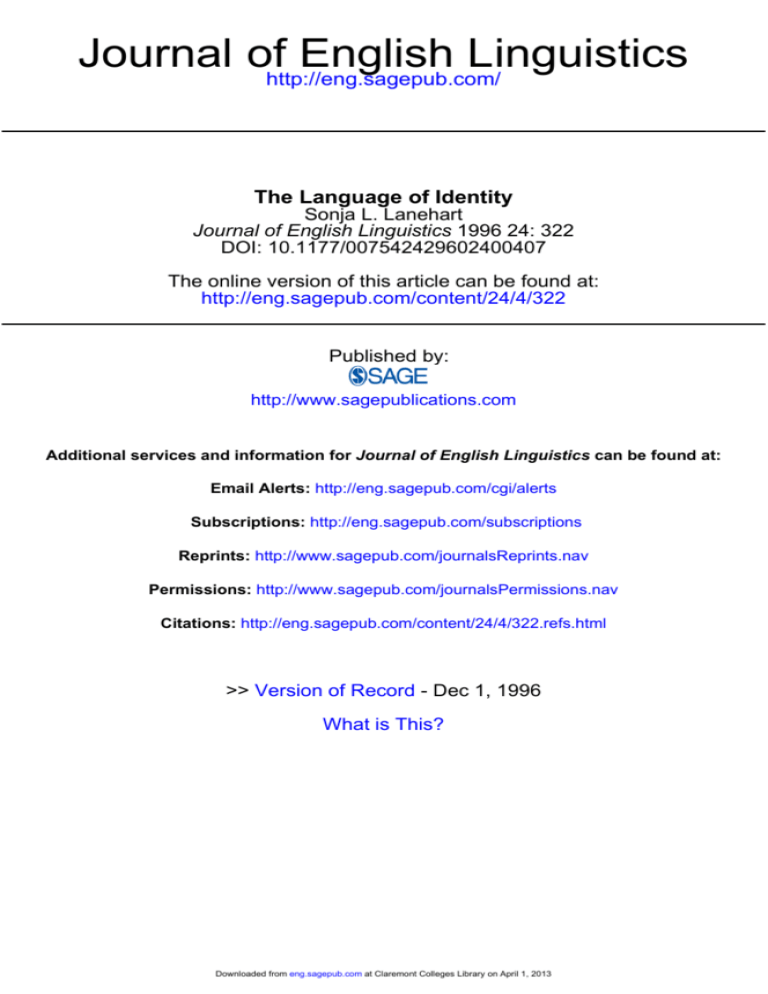
Journal ofhttp://eng.sagepub.com/ English Linguistics The Language of Identity Sonja L. Lanehart Journal of English Linguistics 1996 24: 322 DOI: 10.1177/007542429602400407 The online version of this article can be found at: http://eng.sagepub.com/content/24/4/322 Published by: http://www.sagepublications.com Additional services and information for Journal of English Linguistics can be found at: Email Alerts: http://eng.sagepub.com/cgi/alerts Subscriptions: http://eng.sagepub.com/subscriptions Reprints: http://www.sagepub.com/journalsReprints.nav Permissions: http://www.sagepub.com/journalsPermissions.nav Citations: http://eng.sagepub.com/content/24/4/322.refs.html >> Version of Record - Dec 1, 1996 What is This? Downloaded from eng.sagepub.com at Claremont Colleges Library on April 1, 2013 The Language of Identity SONJA L. LANEHART University of Georgia Language can be a means of solidarity, resistance, and identity within a culture or social group. Though language consists of arbitrary signs, symbols, or sounds constructed to make meaning, its purpose is not simply to communicate, nor is communication necessarily its most essential function. Freire and Macedo (1987, 128) claim that &dquo;language should never be understood as a mere tool of communication&dquo; and, from an entirely different perspective, Bakhtin (1986, 67-68) makes a similar claim: &dquo;Language arises from man’s need to express himself, to objectify himself.... And if language also serves as a means of communication, this is a secondary function that has nothing to do with its essence.&dquo; The language that a person speaks is the language that person identifies with. Language is a part of one’s culture and identity, as people associated with various kinds of scholarship have emphasized (e.g., Freire and Macedo 1987; Heath 1983; Le Page 1986; Milroy and Milroy 1991; Milroy 1987). To try to dictate and purge a person’s language is to try to change the individual, to alter that person’s identity, which can make profound, probably unnecessary, and possibly detrimental demands on his or her culture and person (see Freire and Macedo 1987; Milroy and Milroy 1991 ). At present, two constructs explicate the link between language and identity: Lesley Milroy’s social networks and Robert Le Page’s acts of identity. Lesley Milroy’s social networks construct proposes that &dquo;varieties of language are subject to maintenance through pressure exerted by informal ties of kin and friendship&dquo; (Milroy and Milroy 1991, 58). It provides insight into why low-status local and regional varieties have such a strong capacity to persist despite the institutional pressures that favor standard English, and they accept the view that &dquo;any attempt to eliminate or stigmatize a nonstandard variety will not work, and will be seen as a direct attack on the values and social identity of the speaker&dquo; (108). The extent of this identity depends on the strength and density of the social network(s). While Milroy focuses more on language and community, Le Page (1986, 23) accentuates language and the individual: People create their linguistic systems (and we all have more than one) so as to resemble those of the groups with which from time to time they wish to Journal of Enghsh Linguistics. Vol 24 / No 4, December 1996 322-3311 © 1996 Sage Publications. Inc 322 Downloaded from eng.sagepub.com at Claremont Colleges Library on April 1, 2013 323 identify. Both the groups, and their linguistic attributes, exist solely in the mind of each individual. When we talk we project the universe as we see it on to others as on to a cinema screen in our own images, expressed in the language we consider appropriate at that moment, and we invite others by these acts to share our universe. This does not necessarily mean that we accommodate our behavior to resemble that of our audience, though we may do so. Rather, we behave in the way that—unconsciously or consciously—we think appropriate to the group with which at that moment we wish to identify. This may be quite distinct from the group we are talking to. Little can be done to erase language choice as long as we are social beings with individual and community identities. Our identities emerge from our transactions. We develop within a culture, or cultures, in which language is important. Our experiences within our culture(s), our community, our family, schools, the media, and our jobs help shape the person we are continually becoming. These relationships with other people and institutions are constructed within the realm in which our identity emerges—our sociocultural and historical context. Educational and social psychology may help provide a different perspective on the realities and possibilities of integrating other areas of research more fully into language-linguistics research by seeing language as composed of culture, identity, motivation, and goals. Hazel Markus and Paula Nurius’s (1986, 954) possible selves construct helps us make that step: Possible selves represent individuals’ ideas of what they might become, what they would like to become, and what they are afraid of becoming, and thus provide a conceptual link between cognition and motivation. Possible selves are the cognitive components of hopes, fears, goals, and threats, and they give the specific self-relevant form, meaning, organization, and direction to these dynamics. Possible selves are important, first, because they function as incentives for future behavior (i.e., they are selves to be approached or avoided) and second, because they provide an evaluative and interpretive context for the current view of self.... An individual is free to create any variety of possible selves, yet the pool of possible selves derives from the categories made salient by the individual’s particular sociocultural and historical context and from the models, images, and symbols provided by the media and by the individual’s immediate social experiences. Possible selves thus have the potential to reveal the inventive and constructive nature of the self but they also reflect the extent to which the self is socially determined and constrained. Both Markus and Nurius’s possible selves and Le Page’s (1986) acts of identity indicate that the individual—integrated with the social, cultural, and environmental Downloaded from eng.sagepub.com at Claremont Colleges Library on April 1, 2013 324 experienced and perceived----creates a self posited within a communal of concept self. The individual is not alone in society, but the purposes and functions or constructions of the individual are his or her own to configure, interpret, and transact. In other words, the individual creates a holistic self, a transactive self, and a self self (so to speak) all as part of one multidimensional identity. We are in control as much as our posited selves deem appropriate or necessary. All of this is constructed within the parameters and goals we can envision for ourselves. That embodiment is navigated within our sociocultural and historical context. The construction of self provides an important link between psychology and language-linguistics. Views that inform either discipline with information about the self and its relationship to society as a whole are important to our understanding and appreciation of who and what we are and who and what we have the potential and desire to be(come). The intersections between possible selves and acts of identity (or even social networks) lead directly into the issue of goals: inherent in the constructs of self is what the individual desires and where, as well as how far, the individual dares to go. Such interaction is situated in an ecological, sociocultural, and historical context that cannot be judiciously separated from the individual as self and the individual as part of a greater whole. Language research can interrelate goal theory and motivation into its discourse and objectives. A better understanding of people engaged in learning language varieties can be gained by looking at research on goals. Use of goal research can address the desire to learn a language or language variety and those situations that provide for such learning, and the linguistic researcher can also integrate goal research with work in social, cultural, or educational psychology to develop a theoretical and practical conception for the acquisition of languages and linguistic varieties from an individual’s perspective. There are certainly several links between one’s goals and the direction of one’s thoughts and behavior. As discussed here, goals are defined as subjective representations of what we would like to have happen and what we would like to avoid in the future (Schutz forthcoming). Social networks, acts of identity, and possible selves are transactive components with goals and subgoals in one’s continually evolving self. Goals develop out of the person’s experiences. contexts organization process related to the representation of our subjective knowing are the goals and standards that we attempt to attain and maintain. In other words, not only are goals important in terms of understanding what The behavior is directed towards but also in terms of what is attended to in the environment and what and how we recall the experiences we have in the environment. (Schutz forthcoming) Downloaded from eng.sagepub.com at Claremont Colleges Library on April 1, 2013 325 This is the connection between goals and possible selves as well as goals, possible selves, and the language of identity. Possible selves "derive from representations of the self in the past and they include representations of the self in the future. They are different and separable from the current or now selves, yet are intimately connected to them" (Markus and Nurius 1986, 954). We are forever shaped by our past and present experiences. However, we also shape our views of our experiences based on the transactions we have with the various entities within our sociocultural and historical context. We are not always conscious or aware of this shaping, but it seems inevitable that at some point in our lives we realize or experience the language of identity. This seems even more prominent for speakers in language-minority communities. When language-minority speakers realize their difference and see that it has value—whether positive or negative—conscious choices are made. We choose to move in one direction or another (e.g., toward family or community or school). Whichever direction we choose, we are still transacting with other entities in our linguistic context that help define and shape what our current or now selves are as well as our future possible selves. A fitting expression of this point is the old saying, "You can take the boy out of the country but you can’t take the country out of the boy." Our possible selves and the identity, or identities, we choose are continually evolving based on our past and present transactions with the various entities within our sociocultural and historical context. Those transactions help make us who we are and how we see our possibilities. Figure 1 is a model I am developing to provide a way to visualize the transactional relationships I see as part of the concept of identity. It serves to illustrate the transactional relationships we have as part of our language identities. Language goals, behavior, possible selves, and ideologies and beliefs are integral parts of our identity. Likewise, our identity is an integral part of our sociocultural and historical context. That context consists of entities and social constructions that are part of our transactions as humans, such as family, community, and occupation. We continually shape and are shaped by these transactions with the choices and changes such transactions foster. Milroy’s (1987) social networks construct and Le Page’s (1986) acts of identity construct take many of the transactions illustrated in the model into account when trying to describe our language identity. The efficacy of our identities is defined by the efficacy of our relationships with particular aspects of our sociocultural and historical context. If we have strong ties with our community, we can easily choose to identify with aspects of our community that make it different from other entities we transact with. If we have strong ties with education, we can choose to identify with the aspects that make it different from other entities we transact with. Downloaded from eng.sagepub.com at Claremont Colleges Library on April 1, 2013 326 Figure 1: Language and Identity Model. There may certainly be overlap with our family and community or family and work or education and community or a host of other entities. Dilemmas arise when there is not enough overlap to reconcile the differences between entities. Discordant relationships between entities within our sociocultural and historical context create problems in choosing what or who to identify with. Examples may be found in our schools whenever children receive disparaging remarks about their language. Though the remarks may have little to do with language and more to do with the person using the language, it amounts to the same since the two are inextricably linked. Such attacks influence one’s ever emerging language identities. It is expected that there will be discordance among the many entities that help shape who we are and who we become; however, some conflicts are more harmful than others because some things are more important to us than other things. For some people, the ties between them and their family or them and their community are more important than the connection they have with education or their job. When there is a clash, the stronger identification will usually win out-or go down in defeat with much pain and suffering-but not without a fight. That does not mean that education or one’s job is not important or that they have no effect on the person. It does mean that each of us makes choices that influence who we are, who we become, and who we want to become as well as who we do not want to become (Markus and Nurius 1986). At some point, we may find it difficult to live with the choices. Downloaded from eng.sagepub.com at Claremont Colleges Library on April 1, 2013 327 Part of the decision for an African American English speaker contemplating learning and speaking standard English, for example, is based on both positive and negative perceptions of what a standard English speaker is and what it means to speak standard English. In many areas, not only of the African American community but other language-minority communities as well, speaking standard English is equated with speaking White or trying to be White. Such a perception produces a conflict for an African American (or other language-minority) speaker because the choice to speak standard English is equated with the choice not to be Black. Choosing to speak only African American English means choosing community over assimilation. A hypothetical scenario might help to visualize this situation more concretely. Consider the case of someone we can call Felicia: she believes African American English is important to her identity as an African American. She also believes that standard English is important for success: she wants to teach in her community, but she would have to speak standard English according to the prevailing requirements in the schools. What becomes of her goals? What happens to the possible selves &dquo;Felicia the teacher&dquo; and &dquo;Felicia the African American leader&dquo;? Some do not see the choice of which language variety to speak as a choice between community and assimilation but instead a choice, perhaps, between getting a good job or not getting a good job. Despite the lack of evidence supporting such a correlation (Graff 1979, 1987a, 1987b; Kaestle et al. 1991), many who speak African American English believe in the ideology espoused by schools and society that one must speak standard English to succeed or to have better job opportunities. Those who do believe in this particular ideology of opportunity must face the conflicting feelings involved in their language choice. If as scholars and educators we keep in mind those transactional relationships as well as the conflicts involved, we can better address language diversity and acceptance in an already diverse society that nonetheless harbors wishes that it were a homogeneous one. If we do not, we will only serve to polarize and intimidate the language identity of those who choose to identify with an entity that may conflict with other entities operating in one’s sociocultural and historical context. To bring this problem down to a particular, personal level, I am often told I speak &dquo;proper&dquo; English. I share features of African American English, but it is not a mode I often communicate in or one that is often associated with me-even by my husband. He teases me when I talk to a family member because he says I &dquo;try&dquo; to sound Black-but I don’t. He does not associate my speech with that of others in my family, just as others in my family do not associate my speech with theirs. Yet I do possess several features of African American English in my speech. They are most likely operative when I am talking to my family (or sometimes other African Americans). Oddly enough, my family does not seem to notice when I use linguistic Downloaded from eng.sagepub.com at Claremont Colleges Library on April 1, 2013 328 features of African American English. I do not remember when or how my language changed, but I know my schooling was influential as well as my acceptance of the indoctrination of schooling. Now I often struggle with how people look at me when I talk, as if I am not what they expected of an African American. I struggle with my community’s attitudes and beliefs about &dquo;good&dquo; language and &dquo;bad&dquo; language. I agonize when I am expected to &dquo;correct&dquo; an African American English speaker. Our perceptions of our language are integrated with our perceptions of our selves. Because of that, when we talk about language we should also talk about identity and goals and possible selves since they are at stake-and at risk. To change a person’s language is to change the person. Dialogue is silenced through the power relation that delegitimizes arguments and ideas that are not articulated in acceptable discourse or fashionable jargon (Attinasi 1993). Students have voices, and their voices are being quelled by those who claim to have &dquo;the best interest of the students at heart&dquo; or who are &dquo;only doing their jobs in preparing students for the real world.&dquo; If students choose to use the language of their culture, which in turn is the language of their identity, one cannot object to that based on the false belief that one must use standard English or risk failure. It has been documented by Harvey Graff ( 1979,1987a,1987b), Carl Kaestle et al. ( 1991 ), John Ogbu ( 1978, 1990, 1991 ), and James Paul Gee ( 1990), among others, that success, acceptance, or better job opportunities do not necessarily follow because one uses standard English. The ideology of opportunity through upholding linguistic standards does not hold up when race, social class, and gender are taken into account. Race, class, and gender are critical social constructions that often supersede one’s ability to speak a mythical standard English. We should be concerned with the ideologies of standard English espoused in the classroom as well as in the media and by the government. Millions of people buy into the rhetoric and ideology of the institutions that hold power. Those who have the army and the navy set the model and the standards for society, as the saying goes, and many in society accept the model and the standards at face value without looking critically at what they are being told or why. James Baldwin (1990, 87) has written that the brutal truth is that the bulk of White people in America never had any interest in educating Black people, except as this could serve White purposes. It is not the Black child’s language that is despised. It is his experience. A child cannot be taught by anyone who despises him, and a child cannot afford to be fooled. A child cannot be taught by anyone whose demand, essentially, is that the child repudiate his experience, and all that gives him sustenance, and enter a limbo in which he will no longer be Black, and in which he knows that he can never become white. Black people have lost too many Black children that way. Downloaded from eng.sagepub.com at Claremont Colleges Library on April 1, 2013 329 In the end, many people qualify as neither jacks of all discourses nor masters of any discourse. There are only more and more casualties. Because we live in an oppressive society, it is no surprise when those who are oppressed internalize the very rhetoric and ideology of their oppressors (Freire 1989; Kristeva 1982). The oppressed buy into the arguments of their oppressors because they believe they can overcome their circumstances and not lose their identities by emulating those who oppress them. They believe in the American Dream and the &dquo;pulling yourself up by your bootstraps&dquo; philosophy without regard to race, class, ethnicity, or gender. Take, for example, Shelby Steele, Clarence Thomas, and Dinesh D’Souza. They marginalize, neglect, and denigrate their culture and ways of being just like the oppressors do because they allow their oppressors to convince them that such things are true. In such a mentality, the oppressed take the blame for something that is not even a matter of fault. The issue lies within the realm of our sociocultural and historical context and the transactions we have in that context. Furthermore, the goals and possible selves we choose, as well as the beliefs and behavior we choose, are so integrated into the fabric of our being that attacks against our language cannot be expected not to be detrimental to who we are. Such attacks are all the more devastating when they are internal. The model illustrated in Figure 1 is enclosed and overlapping for a reason. Those entities are not separate from who we are and what we experience because those entities are our experiences. I am not saying that African Americans should not use standard English. I am also not saying that mainstream White Americans should not use either standard English or African American English. What I am saying is that language use is a choice, and the choice for African Americans has been very limited historically because we have been told that our experiences do not matter, or that they are not relevant, because they are different and therefore inferior. We are again and again told that we have to assimilate; we have to accommodate another’s sociocultural and historical context because ours is not acceptable. That is not acceptable. Schools can broaden the spectrum of tolerance and acceptability for different languages as well as linguistic differences in the English language by teaching primary-school children a foreign language using an immersion model (especially since they would more easily be able to become fluent in the language at such a young age) and teaching middle and high school students the history of the English language. By teaching children a foreign language by immersion, the school is acknowledging the importance of other cultures. Students in American schools would thereby move away from thinking that they are the center of the universe and realize that we all have something important to contribute in part because of our differences. Hence language differences would be more likely to be seen as something good or as something simply different rather than as something inferior or something to be feared or shunned. Downloaded from eng.sagepub.com at Claremont Colleges Library on April 1, 2013 330 An atmosphere and curriculum in which primary- and secondary-school students are positively exposed to the many varieties of the English language should be incorporated. By learning about the history of the English language and varieties of English in the United States, such as African American English, Inland-Northern, Southern, Eastern New England, New York City, and Texas English, as well as other varieties of the English language spoken around the world, students and teachers might become more accustomed to language diversity and, thereby, become less ethnocentric. Not only would students and teachers value their own voice and identity, they would also be more sensitive to the importance of voice and identity for others. This is possible in a school system that values first what the student has to say, as opposed to whether the student says it &dquo;correctly.&dquo; Ideas, critical thinking, identity, and voice should be primary concerns; pronunciation and grammar should be matters of choice. If ignorance and ahistoricism might be combatted by educating people about the history of the English language, then we should try it. As it is now, language diversity is discouraged to the extent that many students are made to feel insecure, inferior, and unintelligent. As a consequence of this ethnocentrism, too many students (and teachers and administrators) in turn project those same pernicious feelings onto others. To understand and cope better with the linguistic diversity that will continue to exist, preservice teachers need to be required to know about varieties of American English to avoid requiring students to displace their language for the arbitrary standards of a society that consistently ignores or shuns them. They also need to address the issue of linguistic racism as well to help stop the continuing misdiagnosis of children as mentally deficient when they are really linguistically different. Change is important and natural in more than just language. If we naturally change during the course of our lives as individuals, it is only natural that an artifact so integrated into our very being would change as well. Is that really all that bad? References Attinasi, John J. 1993. Racism, Language Variety and Urban U.S. Minorities: Issues in Bilingualism and Bidialectalism. Racism, Language Variety and U.S. Minorities 27 February, 1-36. Bakhtin, M. M. 1986. The Problem of Speech Genres. In Speech Genres and Other Late Essays, edited by C. Emerson and M. Holquist, 60-102. Austin: University of Texas Press. Baldwin, James. 1990. If Black English Isn’t a Language, Then Tell Me, What Is? In In Depth: Essays for Our Time , edited by C. Klaus, C. Anderson, and R. Faery, 85-87. San Diego: Harcourt, Brace. Downloaded from eng.sagepub.com at Claremont Colleges Library on April 1, 2013 331 Freire, Paulo. 1989. Pedagogy of the Oppressed. Translated by Myra Bergman Ramos. New York: Continuum. Freire, Paulo, and Donaldo Macedo. 1987. Literacy: Reading the Word and the World. South Hadley, MA: Bergin and Garvey. Gee, James Paul. 1990. Social Linguistics and Literacies: Ideology in Discourses. London: Falmer. Graff, Harvey J. 1979. The Literacy Myth: Literacy and Social Structure in the Nineteenth-Century City. New York: Academic Press. —. 1987a. The Labyrinths of Literacy: Reflections on Literacy Past and Present. London: Falmer. 1987b. The Legacies of Literacy: Continuities and Contradictions in Western Culture and Society. Bloomington: Indiana University Press. Heath, Shirley Brice. 1983. Ways with Words: Language, Life, and Work in Communities and Classrooms. Cambridge, UK: Cambridge University Press. Kaestle, Carl F., Helen Damon-Moore, Lawrence C. Stedman, Katherine Tinsley, and William Vance Trollinger, Jr. 1991. Literacy in the United States: Readers and Reading Since 1880. New Haven, CT: Yale University Press. Kristeva, Julia. 1982. Women’s Time. In Feminist Theory: A Critique , of Ideology edited by N. O. Keohane, 31-53. Chicago: University of Chicago Press. Le Page, Robert B. 1986. Acts of Identity. English Today 8:21-24. Markus, Hazel, and Paula Nurius. 1986. Possible Selves. American Psychologist 41:954-69. Milroy, James, and Lesley Milroy. 1991. Authority in Language: Investigating Language Prescription and Standardization. 2d ed. London: Routledge & Kegan Paul. Milroy, Lesley. 1987. Language and Social Networks. 2d ed. Oxford, UK: Basil Blackwell. Ogbu, John U. 1978. Minority Education and Caste: The American System in Cross-Cultural Perspective. New York: Academic Press. —. 1990. Minority Status and Literacy in Comparative Perspective. Daedalus —. 119 (2):141-68. 1991. Cultural Models and Educational Strategies of Non-Dominant Peoples. Paper read at the 1989 Catherine Molony Memorial Lecture, New York. Schutz, Paul A. Forthcoming. Goals, Subgoals, and Standards in Self-Regulated Learning. In Strategic Learning: Skill, Will, and Self-Regulation , edited by C. E. Weinstein and B. McCombs. Hillsdale, NJ: Lawrence Erlbaum. —. Downloaded from eng.sagepub.com at Claremont Colleges Library on April 1, 2013
